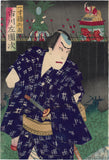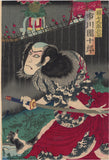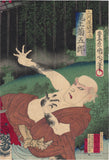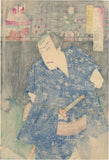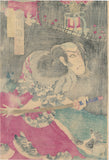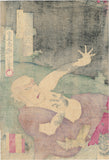Kunichika: Tattooed Danshichi Drawing His Sword; A Mirror of the Osaka Summer Festival (Natsu matsuri Naniwa kagami夏祭浪花鑑) (Sold)
Artist: Toyohara Kunichika (1835-1900)
Title: Tattooed Danshichi Drawing His Sword: A Mirror of the Osaka Summer Festival (Natsu matsuri Naniwa kagami夏祭浪花鑑)
Date: 1883, July 8
The famous night scene of tattooed Danshichi performing the behind-the back thrust that kills Giheiji, who is seen at right falling into the mud. This is known as the Mud Scene (doro-ba泥場) as well as Behind the Nagamachi (Nagamachi ura長町裏) , the seventh scene in this very popular play. In the center we see tattooed Danshichi Kurobei 団七九郎兵衛 played by Ichikawa Danjuro 市川団十郎. On the right is Mikawaya Giheiji 三河屋儀平次 played by Onoe Kikugoroo尾上菊五郎. At left Issun Tokubei 一寸徳兵衛 played by Ichikawa Sadanji市川左團次. They are behind a tall wall in Nagamachi, and on the other side of the fence we see the Natsu matsuri summer festival taking place.
A brief outline of this complex kabuki drama is as follows: Danshichi was orphaned as a child, but was saved by Giheiji. Danshichi became a fishmonger (hence the tattoos) and he married Giheiji`s daughter Okaji and they had a child together. He had the strong heroic kabuki spirit of saving the weak against the strong, as did a friend of similar ilk, Issun Tokubei, shown here. In this scene however, Danshichi actually kills his father-in-law, Giheiji, who was blinded by his greed. Giheiji had kidnapped Kotoura for money, who was the lover of Tamashima Isonojo, who was the son of Tamashima Hyodayu, Dan-shichi’s benefactor. In the scene Dan-shichi tries at first to persuade Giheiji with patience, but the argument ends with fighting in the mud. Dan-shichi was provoked by Giheiji’s words and pulled out his sword and killed him. He is often shown thrusting his sword in a behind-the-back maneuver, as here. In another scene often shown in prints, Danshichi then washes off the blood of his crime with water from a well.
This play first appeared as as jôruri puppet drama at Takemoto-za in Osaka, and shortly after it was turned into a nine-act Kabuki play. It became a great hit and was performed almost every year in summer in Osaka. One can now even find this famous scene from puppet theater and kabuki available to watch on Youtube.
Condition: Excellent impression and color. Very good condition. A few pinholes, smudges and minor trimming.
Dimensions: ôban triptych (34.8 x 71.7 cm)
Signature: Toyohara Kunichika hitsu
SKU: KCA119









